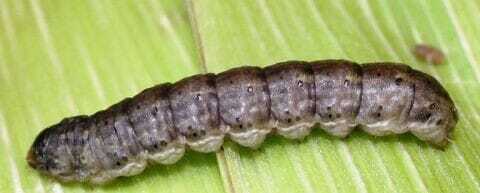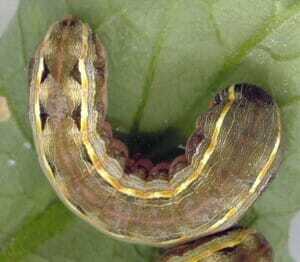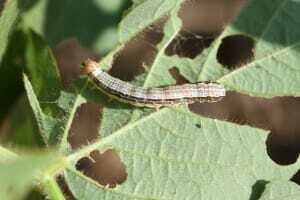Armyworms and Cutworms in Soybeans
Armyworms and cutworms are known to reduce soybean stand and yield by feeding and cutting. Armyworms damage leaf tissue while cutworms clip young plants just above the soil. These worms are differentiated by their appearance.
Cutworm
Soybean cutworm species include dingy cutworm, variegated cutworm and black cutworm. Cutworms begin feeding on winter weeds before moving to soybean plants. Cutworms will burrow in the soil surrounding injured plants. Smaller larvae will feed on leaves and larger larvae will cut the plants.
Scouting and Treatment
Begin scouting for cutworms at emergence. The most common signs of cutworm infestation are cut plants, discoloration or wilting leaves. Reduced tillage, no-till and corn on corn rotations can make cutworm infestation more likely. Legume cover crops can also attract cutworms. This protective vegetation should be removed from the soil at least two weeks before planting.
Mature soybeans are the most resilient to yield loss from cutworms. As advised by researchers from Iowa State University, insecticide treatment should also be applied if more than 20% of feeding damage is observed and larvae are smaller than ¾ inch in length.
Armyworm
The yellow-striped armyworm and fall armyworm are two popular armyworm species. Armyworms grow to be two inches long and feed on both soybean leaves and pods.
Scouting and Treatment
Typically, only one generation of armyworms can be produced in the Midwest due to their inability to overwinter in the cold. Armyworms like to seek shelter in winter annual weeds and grasses. Poorly drained fields can also be an attractive environment for armyworms to dwell.
Applying insecticide is recommended when armyworms are less than one inch. Once armyworms mature and exceed 1 ¼ inches in size, they will stop feeding so it is unnecessary to apply insecticide. Contact your local Latham Representative to assess the best options for treating armyworm and cutworm infestation in your soybeans.



